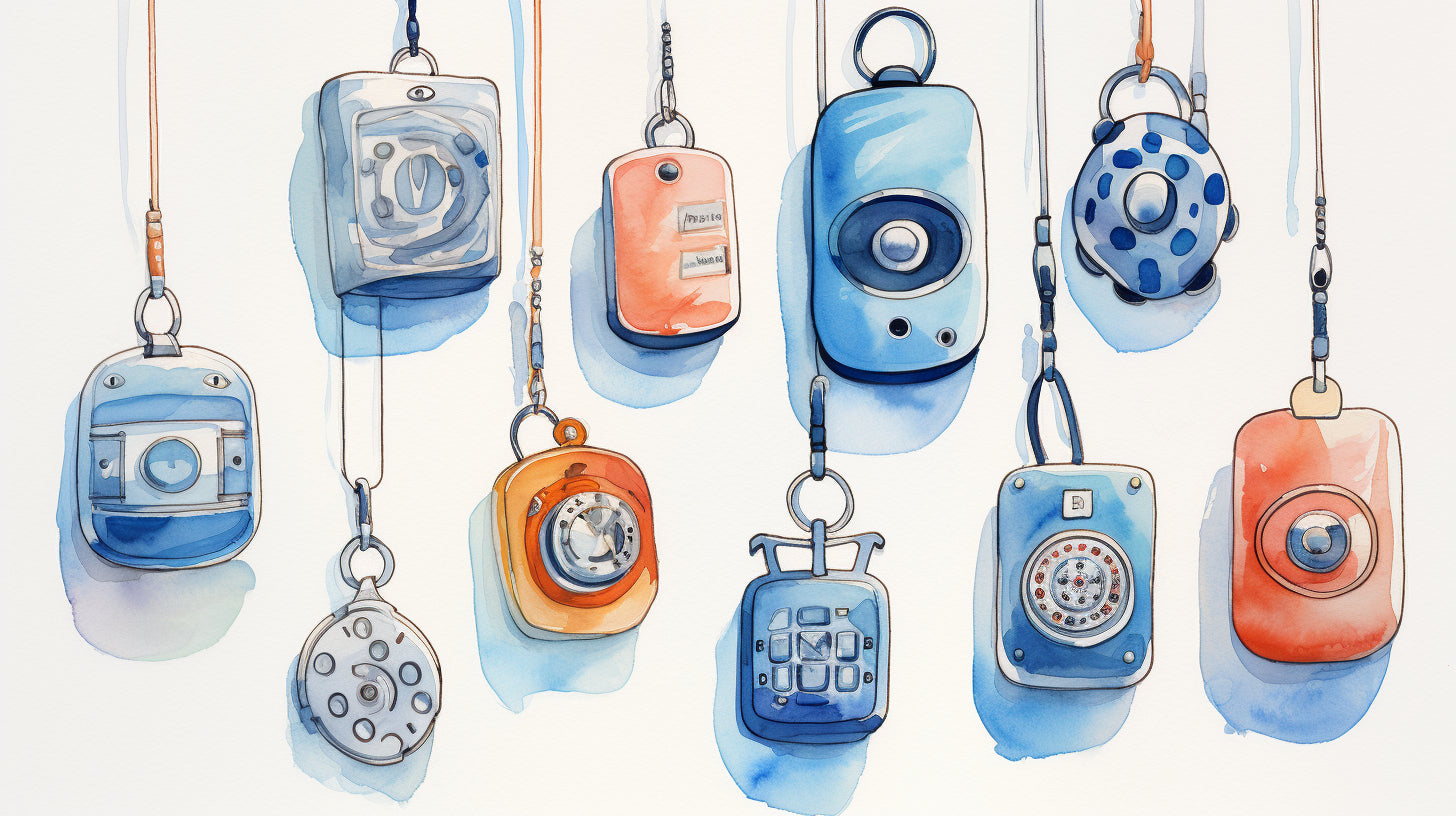Welcome to the world of personal safety alarms! In this in-depth analysis, we will explore everything you need to know about these handy devices that can help protect you in various situations. Whether you're a student walking home at night, a runner exploring new trails, or a traveler adventuring in unfamiliar territories, personal safety alarms can provide you with peace of mind and an added layer of security.
In this article, we will cover the following topics:
- The importance of personal safety and how it impacts our daily lives
- The different types of safety alarms available in the market
- Key features to consider when choosing a safety alarm that's right for you
- Tips on using safety alarms effectively to maximize their benefits
- A comparative analysis of some of the top safety alarms currently available
- Safety alarms in different settings, such as at home, during outdoor activities, and while traveling
- Legal considerations and regulations surrounding the use of safety alarms
- How to make personal safety a lifestyle by incorporating self-defense training, situational awareness, and community support
So, get ready to empower yourself with knowledge and make informed decisions about your personal safety. Let's dive in and conquer the world of personal safety together!
Understanding the Importance of Personal Safety
In our fast-paced world, personal safety has become a top priority for many individuals. Whether you're walking alone at night, traveling to new places, or simply going about your daily routine, it's crucial to be aware of potential dangers and take steps to protect yourself. In this section, we will delve into the importance of personal safety and the factors that contribute to it.
Statistics and Trends
- According to the National Crime Victimization Survey, an estimated 3.7 million incidents of household theft occur each year in the United States alone.
- In a study conducted by the Pew Research Center, it was found that 75% of Americans worry about falling victim to crime, with concerns higher among women and those living in urban areas.
- The World Health Organization reports that interpersonal violence, including physical and sexual assault, is a leading cause of death and disability globally.
It's evident that personal safety is a prevalent concern for many people around the world. Understanding the statistics and trends can help us recognize the importance of taking proactive measures to protect ourselves.
The Psychological Aspect of Personal Safety
Personal safety extends beyond physical protection; it also encompasses our emotional well-being. Feeling safe and secure in our environment has a profound impact on our mental health and overall quality of life. Here are a few points to consider:
- Peace of Mind: Knowing that you have the tools and knowledge to keep yourself safe can significantly reduce anxiety and fear.
- Empowerment: Taking control of your personal safety empowers you to navigate the world with confidence and independence.
- Prevention: By prioritizing personal safety, you can minimize the likelihood of becoming a victim and avoid potential harm.
To truly understand the importance of personal safety, we must recognize that it's not just about physical protection; it's about cultivating a sense of security and well-being in our daily lives.
"Personal safety is not just about protecting yourself from physical harm; it's also about creating an environment where you can thrive and feel secure."
Types of Safety Alarms
When it comes to personal safety, there are various types of safety alarms available in the market that can help you feel more secure and protected. These alarms are designed to alert others and draw attention to a potentially dangerous situation, giving you a chance to escape or get help. Let's take a look at some of the most popular types of safety alarms:
Keychain Alarms
Keychain alarms are small, compact devices that you can easily attach to your keys or carry in your pocket. They are lightweight, portable, and discreet, making them ideal for everyday use. Keychain alarms are typically activated by pulling a pin or pressing a button, which triggers a loud siren or alarm sound. They are designed to be easily accessible and can be quickly activated in case of an emergency. Some keychain alarms also come with additional features such as built-in LED lights or panic buttons.
Pocket Alarms
Pocket alarms, also known as personal alarms, are small handheld devices that can fit in the palm of your hand or your pocket. They are slightly larger than keychain alarms but still offer portability and convenience. Pocket alarms are activated by pulling a trigger or pressing a button, which sets off a high-pitched sound that can reach up to 130 decibels. The loud noise is enough to startle an attacker or draw attention in a crowded area. Some pocket alarms also have features like LED lights or built-in whistles for added versatility.
Wearable Alarms
Wearable alarms are safety devices that can be worn on your wrist, around your neck, or attached to your clothing. They are designed to be discreet and blend in with your everyday accessories while providing an extra layer of protection. Wearable alarms typically have a panic button or a pull tab that, when activated, emits a loud sound or sends an alert to a connected smartphone. These alarms are convenient and easy to access, especially in situations where you may not have your hands free to reach for a traditional alarm.
Smartphone-Enabled Alarms
With the advancements in technology, there are now safety alarms that can be connected to your smartphone via Bluetooth or a mobile app. These alarms often have additional features like GPS tracking, emergency call buttons, and the ability to send alerts to your contacts or authorities. Smartphone-enabled alarms offer the advantage of convenience and integration with other safety apps on your phone. They can also provide real-time location information if you ever find yourself in a dangerous situation.
It's important to choose a safety alarm that suits your lifestyle and personal preferences. Consider factors such as ease of use, portability, and additional features when making your decision. Ultimately, the goal is to have a reliable and effective safety alarm that can provide peace of mind and help you feel more secure in your daily life.
Features to Consider When Choosing a Safety Alarm
When it comes to personal safety, investing in a reliable safety alarm can be a game-changer. These compact devices are designed to alert others when you're in danger, providing you with an extra layer of security. However, with so many options available in the market, it can be overwhelming to choose the right one for your needs. To help you make an informed decision, here are some key features to consider when choosing a safety alarm:
- Loudness and Sound Patterns: One of the most important features to consider is the loudness of the alarm. The purpose of a safety alarm is to attract attention and deter potential threats. Look for an alarm that produces a loud sound, typically above 100 decibels. Additionally, consider alarms that have different sound patterns, as this can help in alerting people around you more effectively.
- Ease of Use and Portability: A safety alarm should be easy to use, especially during emergency situations. Look for alarms that have a simple activation mechanism, such as a button or a pull tab. Additionally, the alarm should be compact and lightweight, allowing you to carry it with ease wherever you go. Consider options that can be easily attached to your keychain, clipped onto your clothing, or carried in your pocket or bag.
- Battery Life and Durability: It's essential to choose a safety alarm that has a reliable battery life. The last thing you want is for your alarm to die out when you need it the most. Look for alarms that have long-lasting batteries and consider ones that are rechargeable, so you don't have to frequently replace batteries. Additionally, make sure the alarm is durable and can withstand everyday wear and tear.
- Additional Functions and Integration: Some safety alarms come with additional functions that can enhance your overall safety experience. These may include features like built-in flashlights, keychain lights, or even personal locator devices. Some alarms can also be integrated with smartphone apps, allowing you to send distress signals and share your location with trusted contacts. Consider these additional functions to determine whether they align with your specific safety needs.
By considering these key features, you can find a safety alarm that best suits your needs and provides you with peace of mind in various situations. Remember to prioritize your personal preferences and requirements when making a decision.
"When choosing a safety alarm, it's important to consider the loudness and sound patterns, ease of use and portability, battery life and durability, as well as any additional functions and integration it offers."
Using Safety Alarms Effectively
When it comes to personal safety, having the right tools and knowledge is crucial. Safety alarms are one of the most effective tools you can have to protect yourself in times of danger. Whether you're walking alone at night or finding yourself in a potentially risky situation, a safety alarm can be your lifeline. But how exactly do you use safety alarms effectively? Let's explore some tips and tactics to ensure you get the most out of your safety alarm.
Immediate Response Tactics
When faced with a threatening situation, it's important to act quickly and decisively. Here are a few immediate response tactics to consider when using a safety alarm:
- Activate the Alarm: The first step is to activate your safety alarm. Most alarms have a simple button or pull tab mechanism that triggers a loud sound. It's important to familiarize yourself with how your specific alarm works so you can activate it effortlessly in an emergency.
- Draw Attention: The loud sound produced by the alarm is designed to attract attention and deter the attacker. Hold your alarm near your face and use your other hand to shield yourself. This will not only make it easier for people to locate you but also make you less vulnerable.
- Escape to Safety: While the alarm is doing its job of drawing attention, use this opportunity to escape to a safe location. Move towards well-lit areas, crowded places, or find someone who can assist you. Remember, the goal is to remove yourself from the dangerous situation as quickly as possible.
Creating Safety Plans
In addition to using safety alarms in the moment, creating safety plans can help you be more prepared and confident in various scenarios. Here are some key steps to consider when creating a safety plan:
- Identify Potential Risks: Think about the situations in which you are most likely to need your safety alarm. Is it when you're walking alone at night? Or is it when you're in crowded spaces? By identifying the potential risks, you can better strategize the use of your alarm.
- Plan Your Escape Routes: Familiarize yourself with the areas you frequent and identify the nearest exits or safe areas. Knowing where to go in a dangerous situation can save crucial time.
- Practice Situational Awareness: Remain alert and aware of your surroundings at all times. Notice any suspicious individuals or activities in your vicinity. Being aware can help you determine when to activate your safety alarm and take appropriate action.
Informing Authorities
While a safety alarm can help deter an attacker and draw attention from the public, it's also important to involve the relevant authorities. Here's why:
- Police Intervention: In some situations, involving the police is necessary to ensure your safety and the safety of others. If you find yourself in a threatening situation, don't hesitate to call emergency services and provide them with all the necessary details.
- Documentation and Evidence: Reporting incidents to the authorities helps create a record of the events. This documentation can be crucial if you decide to press charges or need legal protection later on. Remember to provide a detailed description of what happened and any evidence you may have.
By combining the immediate response tactics, creating safety plans, and involving the authorities when needed, you can use your safety alarm effectively and increase your overall personal safety.
Remember, safety alarms are just one tool in your personal safety arsenal. It's essential to complement them with other strategies such as self-defense training and situational awareness to ensure your well-being in various scenarios. Stay vigilant, be prepared, and prioritize your personal safety.
Comparative Analysis of Top Safety Alarms
When it comes to personal safety, having the right safety alarm can make all the difference. With so many options available in the market, it can be overwhelming to choose the best one for your needs. In this section, we will provide a comparative analysis of some of the top safety alarms, highlighting their features, pros, and cons. So, let's dive in and find the perfect safety alarm for you!Alarm A: Description and Pros/Cons
- Description: Alarm A is a compact keychain alarm that emits a loud sound when activated. It features a simple one-button operation, making it easy to use in emergencies. The alarm can be attached to keys, bags, or clothing for quick access.
-
Pros:
- Loud sound: Alarm A produces a piercing sound of 120 decibels, enough to grab attention and scare off potential attackers.
- Portability: Its small size and lightweight design make it convenient to carry around wherever you go.
- Durability: Alarm A is made with high-quality materials, ensuring its longevity even with regular use.
- Battery life: The alarm is equipped with a long-lasting battery that will last for months before needing replacement.
-
Cons:
- Limited features: Alarm A is a basic alarm and does not offer additional functions like a built-in flashlight or self-defense options.
- Lack of customization: Some users may prefer a safety alarm with customizable sound patterns or adjustable volume, which Alarm A does not provide.
Alarm B: Description and Pros/Cons
- Description: Alarm B is a pocket-sized alarm that is designed to be discreet yet powerful. It features a sleek and modern design with multiple functions for added convenience.
-
Pros:
- Multiple functions: Alarm B not only emits a loud sound but also has a built-in LED flashlight and a self-defense feature like a pepper spray compartment.
- Customizable sound patterns: Users can choose from different sound patterns to suit their preference or to attract attention in various situations.
- Rechargeable battery: Alarm B comes with a rechargeable battery, eliminating the need for frequent battery replacements.
- Easy to carry: Its compact size and built-in clip make it easy to attach to clothing or bags for quick access.
-
Cons:
- Price: Alarm B may be slightly more expensive compared to other safety alarms in the market due to its additional features and rechargeable battery.
- Size: Some users may find the size of Alarm B too small to handle comfortably.
Alarm C: Description and Pros/Cons
- Description: Alarm C is a wearable alarm that can be worn as a bracelet, pendant, or attached to clothing or bags. It is designed for those who prefer a hands-free option for personal safety.
-
Pros:
- Ease of use: Simply pull the pin or press a button to activate Alarm C, which then emits a loud sound and attracts attention.
- Versatile wearing options: Alarm C can be worn in different ways, allowing users to choose the most comfortable and discreet option for them.
- Stylish design: With a variety of colors and designs available, Alarm C can be a fashionable accessory while still providing personal safety.
- Integration with smartphone: Some models of Alarm C offer smartphone integration, allowing users to connect it to their devices for additional features like GPS tracking.
-
Cons:
- Battery life: As Alarm C is a wearable alarm, the battery life may not be as long-lasting compared to other safety alarms.
- Limited sound options: While Alarm C offers a loud sound, it may not have customizable sound patterns like other alarms.
These are just a few examples of top safety alarms in the market. When choosing a safety alarm, it's crucial to consider your personal preferences, needs, and budget. Remember, the best safety alarm is the one that suits you and gives you peace of mind in any situation. Stay safe!
Safety Alarms in Different Settings
When it comes to personal safety, it's important to stay prepared no matter where you are. Safety alarms can be a valuable tool in various settings, helping to deter potential threats and alert others to your situation. Let's dive into how safety alarms can be used effectively in different environments:
Home Safety
Your home should be a place where you feel safe and secure. However, emergencies can still happen. Safety alarms can provide an extra layer of protection for you and your loved ones. Here's how they can be utilized at home:
- Intruder Alerts: Install safety alarms near entry points such as doors and windows. If someone attempts to break in, the alarm will sound, alerting you and your neighbors to the situation.
- Fire and Smoke Detection: Many safety alarms are equipped with smoke and heat sensors. These alarms can detect a fire or smoke before it becomes a major threat and can provide an early warning to evacuate.
- Carbon Monoxide Detection: Carbon monoxide is a silent killer that is odorless and colorless. Safety alarms with carbon monoxide detectors can help protect you from this deadly gas by sounding an alarm when it detects high levels of carbon monoxide in the air.
Outdoor Activities
Whether you enjoy jogging, hiking, or walking your dog, outdoor activities can sometimes expose you to potential dangers. Safety alarms can be a valuable companion during your adventures. Here's how they can be used outdoors:
- Personal Protection: Attach a safety alarm to your keychain or wear a wearable alarm while engaging in outdoor activities. In case of an emergency or if you feel threatened, activate the alarm to draw attention and deter potential attackers.
- Animal Deterrent: Outdoor safety alarms that emit high-frequency sounds can be effective in scaring away aggressive animals. They can be particularly useful for hikers and campers who may encounter wildlife in their surroundings.
Travel and Commuting
When you're away from the familiar surroundings of your home, it's essential to be equipped with personal safety tools. Safety alarms can provide an added sense of security while traveling or commuting. Here's how they can be used in such situations:
- Public Transportation Safety: Use a safety alarm when travelling on public transportation, such as trains or buses. If you feel threatened or unsafe, activate the alarm to catch the attention of fellow passengers and the driver.
- Hotel Safety: When staying in unfamiliar places like hotels, carrying a safety alarm can help you feel more secure. Activate it if you notice any suspicious activity or if you need immediate help.
- Parking Lot Security: Parking lots, especially in the evenings, can be potentially dangerous spaces. Keep a safety alarm within reach when walking to your car, and activate it if you sense any danger to draw attention and discourage attackers.
Remember, safety alarms are just one tool to help enhance personal safety in different settings. It's essential to trust your instincts, be aware of your surroundings, and follow other safety measures to further protect yourself.
"Personal safety is not just about alarms; it's a combination of preparedness, awareness, and taking proactive measures to protect yourself."
Legal Considerations and Regulations
When it comes to personal safety alarms, it's essential to be aware of the legal considerations and regulations in your area. While safety alarms are designed to protect and empower individuals, there may be specific laws and restrictions that govern their use. Understanding these regulations can help you stay on the right side of the law and ensure that you are using your safety alarm responsibly.
Laws on Personal Safety Alarms
The laws regarding personal safety alarms can vary from country to country and even within different states or regions. It's important to familiarize yourself with the specific laws in your area to ensure compliance. Here are some common legal considerations to keep in mind:
- Permissible decibel levels: Certain jurisdictions may have regulations regarding the maximum volume level for personal safety alarms. This is to prevent unnecessary noise pollution and ensure that alarms are not overly disruptive.
- Permitted use cases: Some regions may have specific rules about when and where you can use a personal safety alarm. They may be limited to certain situations, such as self-defense or emergencies.
- Age restrictions: In some places, there may be age restrictions on the possession or use of safety alarms. These restrictions are typically in place to prevent misuse or accidents involving minors.
- Notification requirements: Certain jurisdictions may require individuals to notify local authorities or obtain permits for the use of safety alarms. This is to ensure that law enforcement is aware of the purpose and intended use of the alarm.
Restrictions on Using Safety Alarms
In addition to specific laws, there may also be general restrictions on using safety alarms to consider. These restrictions are put in place to prevent misuse or disruptions in public spaces. Here are some common restrictions you may come across:
- Prohibited locations: Many public spaces have rules against using personal safety alarms, such as schools, hospitals, or government buildings. These restrictions aim to maintain a peaceful and orderly environment.
- False alarms: Intentionally triggering a false alarm can have legal consequences in some areas. It is important to use personal safety alarms responsibly and only activate them in genuine emergencies or situations where immediate assistance is needed.
- Privacy concerns: Some jurisdictions have restrictions on audio recording or monitoring devices. Safety alarms that include recording capabilities may need to comply with additional regulations to protect individuals' privacy rights.
Researching Local Laws and Regulations
To ensure that you are using your personal safety alarm within the boundaries of the law, take the following steps:
- Research local laws: Familiarize yourself with the specific laws and regulations in your country, state, or city. Check online resources or consult with legal professionals to get accurate and up-to-date information.
- Contact local authorities: Reach out to local law enforcement agencies or relevant authorities to inquire about any permits or notification requirements for using personal safety alarms.
- Follow manufacturer guidelines: Read the user manual or guidelines provided by the manufacturer of your safety alarm. They may include specific instructions or warnings regarding legal considerations and regulations.
- Stay informed: Laws and regulations can change over time, so it's important to stay updated on any developments or amendments that may affect the use of personal safety alarms in your area.
Remember, personal safety alarms are meant to enhance your safety and provide peace of mind. By understanding and adhering to legal considerations and regulations, you can use your safety alarm responsibly and confidently.
Making Personal Safety a Lifestyle
When it comes to personal safety, it's important to go beyond just purchasing a safety alarm. It's about making personal safety a lifestyle and adopting habits that prioritize your well-being. Here are some tips to help you integrate personal safety into your daily routine:
1. Self-Defense Training
Self-defense training is an empowering way to increase your personal safety. Learning basic self-defense techniques can give you confidence and the ability to protect yourself in potentially dangerous situations. Look for local self-defense classes or martial arts schools that offer specialized training for personal safety.
2. Situational Awareness
Being aware of your surroundings is crucial for personal safety. Stay alert and attentive to your environment, whether you're walking down the street, in a parking lot, or using public transportation. Avoid distractions, such as looking at your phone, and trust your instincts if something feels off.
3. Community Support
Building a strong support network can contribute to your personal safety. Connect with neighbors, friends, or coworkers who share a common interest in personal safety. Discuss safety tips, share information about local safety initiatives, or even organize group self-defense classes. Having a community that looks out for one another can enhance your personal safety.
"Being proactive and taking measures to prioritize your personal safety is essential in today's world. Making personal safety a lifestyle means taking action and embracing habits that empower you to protect yourself."
Conclusion
In conclusion, personal safety is a topic that should never be taken lightly. With the unfortunate rise in crime rates and the prevalence of dangerous situations, it's crucial to prioritize your well-being and take proactive measures to protect yourself. Safety alarms are an excellent tool to help you feel more secure and confident in any situation.
By understanding the importance of personal safety and the various types of safety alarms available, you can make an informed decision when choosing the right alarm for your needs. Consider features such as loudness, ease of use, battery life, and additional functions to ensure that your alarm is effective and reliable.
Remember that using a safety alarm goes beyond just owning one - it's essential to know how to use it effectively. Familiarize yourself with immediate response tactics, create safety plans, and inform authorities when necessary. These actions will help maximize the effectiveness of your safety alarm and increase the likelihood of a positive outcome in dangerous situations.
Taking a comparative analysis of top safety alarms can also assist you in identifying the best options on the market. With different alarm descriptions and pros/cons, you can weigh the features and pick an alarm that aligns with your preferences and requirements.
Furthermore, safety alarms can be beneficial in various settings, including your home, outdoor activities, and while traveling or commuting. Each setting presents unique challenges and risks, but having a safety alarm by your side can provide an added layer of protection and peace of mind.
It's important to be aware of any legal considerations and regulations regarding personal safety alarms. Familiarize yourself with the laws in your area to ensure that you are using your alarm within the confines of the law and understanding any restrictions that may be in place.
Lastly, making personal safety a lifestyle requires ongoing effort and dedication. Consider investing in self-defense training, practicing situational awareness, and building a supportive community that prioritizes safety. These steps will help you develop a mindset of preparedness and empower you to take control of your own security.
In conclusion, personal safety is something that should never be compromised. By understanding the importance of personal safety and utilizing safety alarms effectively, you can take control of your well-being and navigate the world with confidence. Stay safe and make personal safety a priority in your everyday life.
Frequently Asked Questions
-
What are safety alarms and how do they work?
Safety alarms are personal security devices designed to alert others when a person is in danger. They typically emit a loud noise or alarm sound to attract attention and deter potential attackers. Some safety alarms also feature additional functions such as flashing lights or self-defense mechanisms.
-
How effective are safety alarms in preventing attacks?
Safety alarms serve as a deterrent by attracting attention and can potentially startle or intimidate attackers. While they may not physically prevent an attack from happening, they increase the chances of others coming to your aid or scaring off the attacker.
-
What types of safety alarms are available in the market?
There are various types of safety alarms available, including personal keychain alarms, wearable alarms, door/window alarms, and personal safety apps for mobile phones. Each type offers different features and benefits to cater to specific safety needs.
-
Are safety alarms suitable for all age groups?
Yes, safety alarms are suitable for people of all age groups who wish to enhance their personal safety. They can be particularly useful for individuals who regularly walk or travel alone, joggers, college students, elderly individuals, and anyone concerned about their personal safety.
-
How do I choose the right safety alarm for my needs?
Consider factors such as portability, ease of use, alarm loudness, battery life, additional features like LED lights or self-defense tools, and customer reviews when choosing a safety alarm. Assess your personal safety concerns and select one that aligns with your specific needs and preferences.




















Leave a comment
This site is protected by hCaptcha and the hCaptcha Privacy Policy and Terms of Service apply.